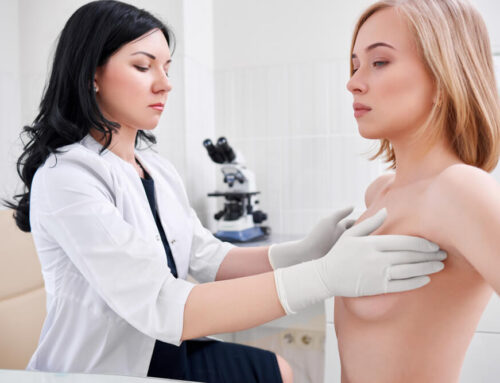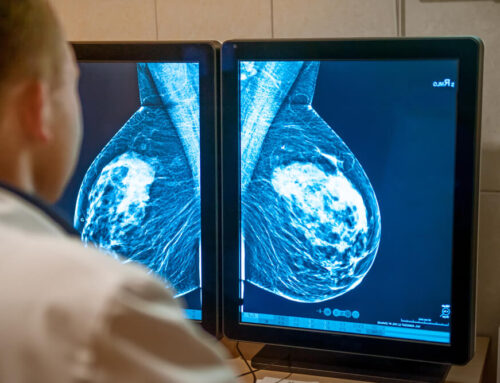Gynecomastia is a condition that occurs when men experience enlargement in the breast tissue. This can affect newborns, adolescents, and older men, as the body has decreased testosterone levels compared to estrogen.
This article focuses on causes and gynecomastia symptoms. It also explores some treatments for gynecomastia symptoms.
What Causes Gynecomastia?
Gynecomastia is a noncancerous condition that occurs when there is a hormonal change in testosterone and estrogen.
Testosterone is the primary sex hormone in males and can affect a person’s appearance and sexual development. Estrogen is another hormone responsible for the female’s reproductive system, and it controls the menstrual cycle and breast growth, among others.
It can occur at different times in a male’s life:
- After birth: Many newborns have enlarged breasts due to the estrogen effects they received when they were still in their mother’s womb. The condition goes away within two to three weeks after a woman gives birth.
- At puberty: Those who are 12 to 14 years old may experience a change in their hormone levels which causes their breasts to grow. However, gynecomastia can take six months to two years after the start of puberty to go away.
- Later in life: Breast enlargement can occur in men who are 50 to 80 years of age.
It can also develop as a side effect of some medications, such as:
- Antidepressants
- Antibiotics
- Chemotherapy
- Cardiovascular drugs
- Prostate cancer medications
Some conditions can also cause gynecomastia, such as:
- Kidney disease
- Lung cancer
- Liver disease
- Testicular cancer
- Thyroid disorders
- Obesity
- Injury

How Do We Diagnose Gynecomastia?
We diagnose this condition by performing a breast exam and asking about your medical history and physical symptoms. For example, breast pain and tenderness are the most common symptoms in men with enlarged breasts. We may also detect a rubbery disk of tissue beneath the nipples.
In addition, it is essential to take note of the medications, supplements, and herbal products that you are taking, as some can increase the risk of gynecomastia.
That said, your physician may perform a breast mammogram and ultrasound to ensure that there are no cancerous cells present in your breasts.
- Mammogram: It produces an X-ray picture of the breasts, and we use it to spot early signs of cancer.
- Ultrasound: It uses sound waves and produces images of the breast’s internal structure. It looks for breast lumps without radiation.
Furthermore, some conditions that have the same appearance as that of gynecomastia include:
- Breast cancer: Although breast cancer is more common in women, it can still develop in men. Breast cancer usually affects one breast, develops a lump, and causes breast lymph nodes to enlarge. Some people also have discharge coming out of the nipples.
- Fatty breast tissue: This affects men who are obese as they have an increase in fat deposits in their breasts. However, keep in mind that gynecomastia does not increase fat deposits, but it causes the glandular tissue to swell.
In the following section, we will explore some gynecomastia symptoms.
What Are the Symptoms of Enlarged Breasts In Men?
People with gynecomastia may experience different symptoms:
Gynecomastia Early Symptoms
What do we mean when we say that someone has early symptoms of gynecomastia? How do they develop?
The condition can occur in one or both of your breasts, and it develops fatty tissue beneath the nipple area, leading to breast soreness. This is the first sign that patients with gynecomastia experience.
Gynecomastia has nothing to do with cancer, but your physician may perform some tests to ensure that the patient doesn’t have breast cancer.
Another symptom associated with breast enlargement in men is swelling. This can cause the breasts to grow unevenly, and we recommend seeing a doctor if your breasts are swollen, painful, or tender. You should also seek medical help if you are experiencing nipple discharge.
In the next section, we will describe what happens when a patient has progressive gynecomastia symptoms.
Gynecomastia Progressive Symptoms
Gynecomastia is not a cancerous condition, but the breasts’ rapid growth can indicate underlying cancer.
The condition can lead to anxiety or depression, as patients may feel embarrassed discussing their symptoms with a family member or doctor. As a result, they may not want to be around other people.
What are the Treatments for Gynecomastia Symptoms?
Most of the time, gynecomastia develops during puberty, and many patients recover without any treatment. As a result, the symptoms can take up to three years to disappear.
However, your physician may offer a treatment plan for your condition, and this may depend on your age and medical history. For example, if you are taking a drug that is causing your breasts to swell, you should speak with your doctor to discuss another course of treatment.
If you have a disease that has developed your gynecomastia, then we will have to treat the disease itself.
That said, treatments for gynecomastia symptoms include:
Medications
If you have gynecomastia symptoms, your healthcare provider may prescribe medications that are also used to treat breast cancer, such as:
- Tamoxifen (Soltamox): This drug can reduce breast size and block the effects of estrogen. Patients can also take tamoxifen with hormonal anti-prostate cancer treatment.
- Clomiphene: It can treat gynecomastia, and people can take it for up to six months.
Surgery
Medications are effective in treating early symptoms of gynecomastia, as scarring can occur after 12 months. However, doctors may recommend surgical removal of the breast tissue that is scarred, as medications are less likely to work in that case.
Two surgery options available for men with breast enlargement include the following:
- Liposuction: Doctors perform this procedure using local anesthesia with sedation or general anesthesia, and they use a suction technique to remove breast fat through incisions. Afterward, the patient may have to wear a compression garment for a few weeks to help reduce swelling and support the healing tissues. That said, patients should avoid doing any vigorous exercise for three weeks.
- Mastectomy: During this procedure, the surgeon removes the breast gland tissue and uses small incisions. Mastectomy may be beneficial for men who have breast cancer, and doctors usually remove the whole breasts as they do not have a lot of breast tissue.
Other: Counseling
Counseling sessions may be helpful for those who have difficulty dealing with this condition. Patients can also join support groups to learn about other people’s experiences and how they deal with the condition.
Can You Prevent Gynecomastia?

People can do the following to reduce the chances of having gynecomastia:
- Reviewing their medications: If they think that the drugs they are taking are causing their breasts to swell, they should ask their physician if there are other treatments available.
- Avoid drinking alcohol
- Avoid the use of recreational drugs such as anabolic steroids, amphetamines, androgens, and marijuana.
Book Your Appointment Today
What are the next steps? What can you do to reduce the symptoms of your conditions?
If you are experiencing swelling, pain, and tenderness in your breasts, it’s time that you have your breasts checked. We perform a breast exam to ensure that the symptoms you are experiencing are not associated with cancer.
We may also ask about your medical history, and we recommend that you do not stop taking any medication without the doctor’s approval.
If you have symptoms of gynecomastia or want to learn more about this condition, call our office today and book your appointment.






